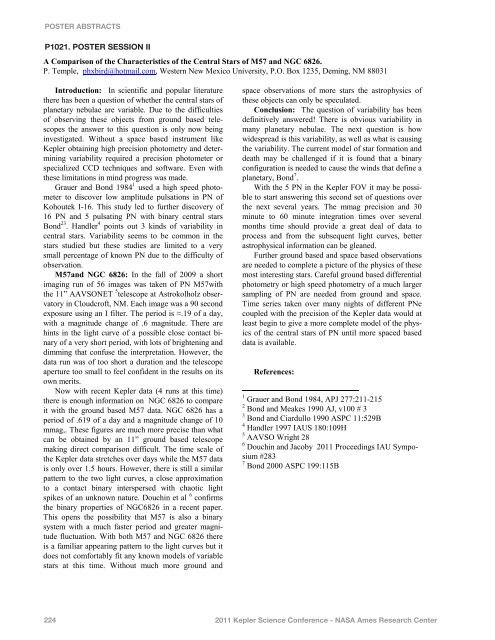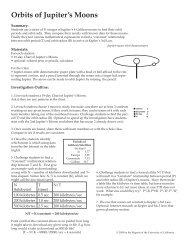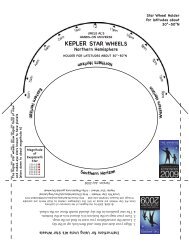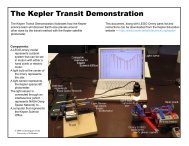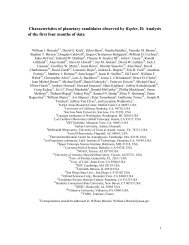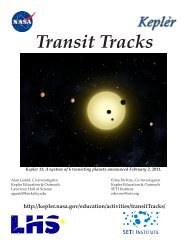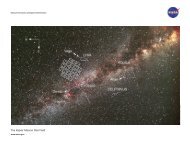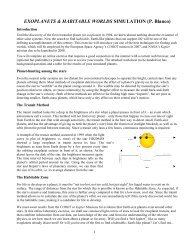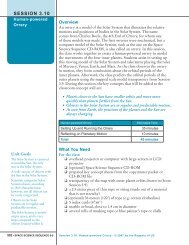POSTER ABSTRACTSP1021. POSTER SESSION IIP. Temple, phxbird@hotmail.com, Western New Mexico University, P.O. Box 1235, Deming, NM 88031 In scientific and popular literaturethere has been a question of whether the central stars ofplanetary nebulae are variable. Due to the difficultiesof observing these objects from ground based telescopesthe answer to this question is only now beinginvestigated. Without a space based instrument like<strong>Kepler</strong> obtaining high precision photometry and determiningvariability required a precision photometer orspecialized CCD techniques and software. Even withthese limitations in mind progress was made.Grauer and Bond 1984 1 used a high speed photometerto discover low amplitude pulsations in PN ofKohoutek I-16. This study led to further discovery of16 PN and 5 pulsating PN with binary central starsBond 23 . Handler 4 points out 3 kinds of variability incentral stars. Variability seems to be common in thestars studied but these studies are limited to a verysmall percentage of known PN due to the difficulty ofobservation. In the fall of 2009 a shortimaging run of 56 images was taken of PN M57withthe 11” AAVSONET 5 telescope at Astrokolholz observatoryin Cloudcroft, NM. Each image was a 90 secondexposure using an I filter. The period is ≈.19 of a day,with a magnitude change of .6 magnitude. There arehints in the light curve of a possible close contact binaryof a very short period, with lots of brightening anddimming that confuse the interpretation. However, thedata run was of too short a duration and the telescopeaperture too small to feel confident in the results on itsown merits.Now with recent <strong>Kepler</strong> data (4 runs at this time)there is enough information on NGC 6826 to compareit with the ground based M57 data. NGC 6826 has aperiod of .619 of a day and a magnitude change of 10mmag,. These figures are much more precise than whatcan be obtained by an 11” ground based telescopemaking direct comparison difficult. The time scale ofthe <strong>Kepler</strong> data stretches over days while the M57 datais only over 1.5 hours. However, there is still a similarpattern to the two light curves, a close approximationto a contact binary interspersed with chaotic lightspikes of an unknown nature. Douchin et al 6 confirmsthe binary properties of NGC6826 in a recent paper.This opens the possibility that M57 is also a binarysystem with a much faster period and greater magnitudefluctuation. With both M57 and NGC 6826 thereis a familiar appearing pattern to the light curves but itdoes not comfortably fit any known models of variablestars at this time. Without much more ground andspace observations of more stars the astrophysics ofthese objects can only be speculated. The question of variability has beendefinitively answered! There is obvious variability inmany planetary nebulae. The next question is howwidespread is this variability, as well as what is causingthe variability. The current model of star formation anddeath may be challenged if it is found that a binaryconfiguration is needed to cause the winds that define aplanetary, Bond 7 .With the 5 PN in the <strong>Kepler</strong> FOV it may be possibleto start answering this second set of questions overthe next several years. The mmag precision and 30minute to 60 minute integration times over severalmonths time should provide a great deal of data toprocess and from the subsequent light curves, betterastrophysical information can be gleaned.Further ground based and space based observationsare needed to complete a picture of the physics of thesemost interesting stars. Careful ground based differentialphotometry or high speed photometry of a much largersampling of PN are needed from ground and space.Time series taken over many nights of different PNecoupled with the precision of the <strong>Kepler</strong> data would atleast begin to give a more complete model of the physicsof the central stars of PN until more spaced baseddata is available.1 Grauer and Bond 1984, APJ 277:211-2152 Bond and Meakes 1990 AJ, v100 # 33 Bond and Ciardullo 1990 ASPC 11:529B4 Handler 1997 IAUS 180:109H5 AAVSO Wright 286 Douchin and Jacoby 2011 Proceedings IAU Symposium#2837 Bond 2000 ASPC 199:115B2242011 <strong>Kepler</strong> Science Conference - <strong>NASA</strong> Ames Research Center
POSTER ABSTRACTSP1022. POSTER SESSION IIDYNAMICS OF PROTOPLANETARY DISKS IN STELLAR CLUSTERS. S. Torres 1 and B. Pichardo 2 ,1 Instituto de Astronomía, Universidad Nacional Autónoma de México, Apdo. postal 70-264 Ciudad Universitaria,D.F., México, storres@astroscu.unam.mx, 2 Instituto de Astronomía, Universidad Nacional Autónoma de México,barbara@astroscu.unam.mx.Introduction: Most stars are born in stellar clusters[1],[2],these are environments where stellar densityreaches 1M¤/pc 3 to 10 4 M¤/pc 3 .Planetary disks around stars in these environmentsare affected by gravitational interactions along theirpassage through these stellar regions. Disk interactionswith stars cause truncations of the disks. The mostabundant stars in the Galaxy (∼ 75%) are called verylow mass stars, this is because the small stars [0.013 to0.6] M¤, burn their fuel slowly and stay a much longertime on the main sequence. With the development oftechnology, astromers have been able to detect planetsaround other stars (688 (26/09/11)), a significant numberof them corresponds to very low mass stars.In this paper we analyzed the dynamics of planetarydisks in very low mass stars that belong the starclusters. We study orbital parameters (eccentricity,inclination, pericenter and apocentre) after the interactionbetween the host and the flyby stars. To achievethis goal we use a code of stellar encounters (EEC).Methodology and Numerical Implementation:The code of stellar encounters simulates the gravitationalinteraction between a planetary system characterizedby a cold disk of test particles in a <strong>Kepler</strong>ian potentialand a hyperbolic orbit of the flyby star. In general,the EEC solves the equations of motion in the noninertialreference system of the central star, providingthe required orbital parameters.The code is 3D. The sampling of orbits goes as a ∝n −3/2 , where a is the semimajor axis of the particle’sorbit, and n is the number of orbits. Particles are underthe influence of the stellar forces (main and flyby star),and the equations of motion are solved from the Sun’snon-inertial frame of reference. The code calculates themain orbital characteristics of the debris disks after aflyby, such as eccentricity, pericenter, apocenter andinclinations. The Bulirsh-Stoer integrator gives a maximumrelative error before the flyby of 10 −14 and10 −13 in the energy and angular momentum integrals,respectively.Simulations and Preliminary Results: To makethe simulations we used the following parameters:1. Host star: For brown dwarfs mass range is [0.013-0.075]M⊙, for these simulations we take the upperlimit, 0.075M⊙ this because they are the most abundantin star clusters. On the other hand, the case of reddwarf mass range is [0.08 to 0.6]M⊙ we know the averagemass of stars in open clusters is 0.5M⊙[3], thatcorrespond to red dwarfs so this mass taken for thesimulations.2. Flyby star: The most abundant stars in open clustersare red dwarfs with a mass of 0.5M ⊙ average, we usethis mass for the simulations.3.Velocity dispersion: The typical velocity dispersionin open clusters is between 1-3km/s. For these simulationswe take 3km/s because this speed is more commonin these environments,[3]. While for the globularclusters, the range is from 5-15km/s. For these simulationswe worked with 8km/s.4.Interaction time: The code is structured as that theinteraction of the perturbing star with the planetarydisk is in a period of 10.000 years.5.Disk: Since dwarf stars have little mass, its planetarydisks have small radii ~ 20 - 80AU (Bate et al. 2002),for brown dwarfs we take an interval [0.1 to 60] AU,while for red dwarfs we work with [0.5-70] AU.6. Interaction angle: We take φ = 0, θ = 45 and α = 45.7. Impact parameter: we working with: 1000, 500,300, 200, 100 AU.Brown Dwarfs (Open Clusters): For 1000AU impactparameter of the disc is not altered. For the impactparameter 300AU the particles in the range of 30-60AU, obtained eccentricities up to 0.7 and inclinationsat 35 degrees. On the other hand the particles at theperiphery of the disk is ejected to more than 100AU.Brown Dwarf (Globular Clusters): For 1000AU interactionthe effect on the disk is negligible, while for200AU the particles are ejected more than 100AU,attain inclinations at 30 degrees and eccentricities up to0.7, the particles between 0 and 15 AU remain unchanged.Red Dwarf (Open Clusters): For 500UA of impactparameter is not altered in the orbital parameters. At200AU begins to be a significant change in the orbitalparameters, since the particles are on the edge of thedisk come to reach 0.5 eccentricities and inclinationsof 40 degrees and are ejected to 100AU. The particlesthat remain unchanged are between 0.5 and 20UA.Red Dwarf (Globular Clusters): For interactions of 500AU, the effect is zero, while for 200AU the interactionof particles in the periphery of the disk (50-70) AUundergo changes in their orbital parameters obtainedinclinations at 20 degrees and eccentricities of 0.2.Conclusion: The Preliminary results show us thatbrown dwarfs stars are more vulnerable than reddwarfs stars to gravitational encounters in stellar clusters,which means it is more difficult the planet forma-2011 <strong>Kepler</strong> Science Conference - <strong>NASA</strong> Ames Research Center 225


